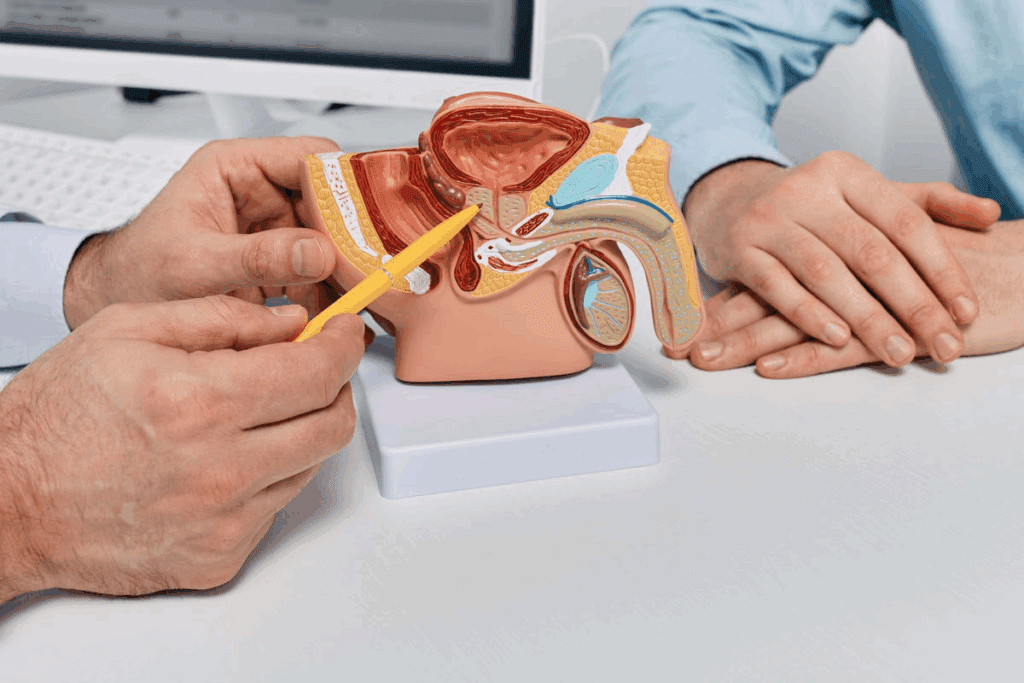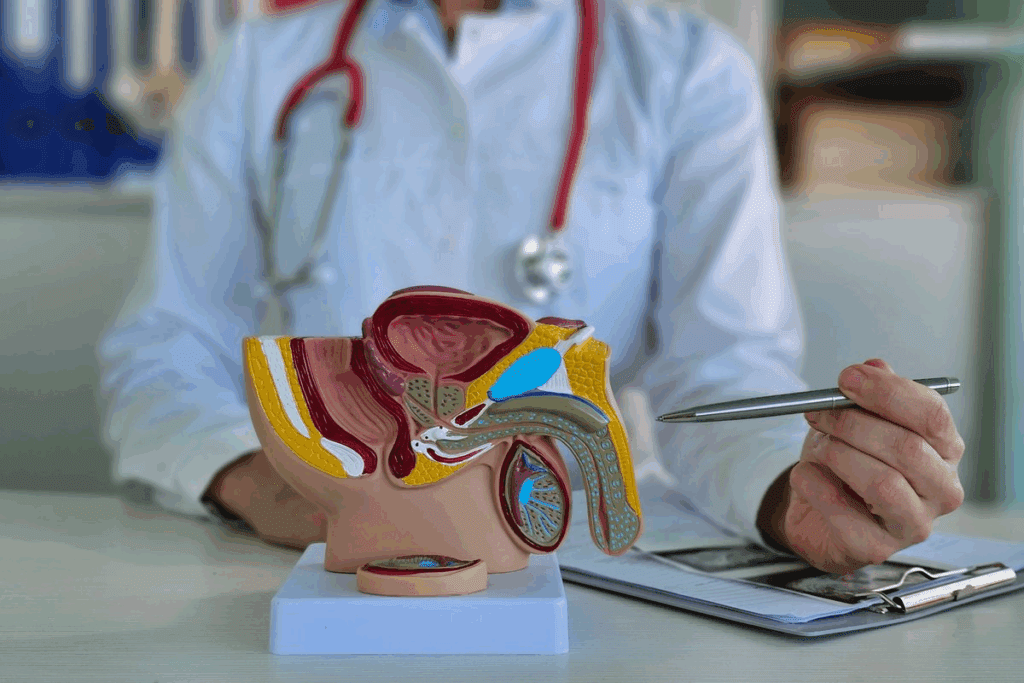Last Updated on November 25, 2025 by Ugurkan Demir

Prostate hormone therapy, also known as androgen deprivation therapy (ADT), is a key treatment for advanced prostate cancer. It works by lowering testosterone levels to slow cancer cell growth. But, this therapy comes with various side effects that can affect patients’ quality of life.
Studies show that hot flashes happen in more than 80 percent of patients on ADT. Knowing about these side effects is key to managing them well. At Liv Hospital, we focus on you, providing all the info and support you need during treatment.
Discover prostate hormone therapy side effects and tips for management.

Androgen deprivation therapy (ADT) is key in treating advanced prostate cancer. It lowers male hormones, or androgens, which prostate cancer cells need to grow.
ADT is a treatment that lowers testosterone levels. Testosterone helps prostate cancer cells grow and spread. By reducing testosterone, ADT slows or stops cancer growth.
There are different ways to do ADT, like medicines and surgery. Medicines include LHRH agonists and antagonists, and antiandrogens. These medicines either lower testosterone production or block its effects on cancer cells.
ADT targets the hormonal pathways that make testosterone. LHRH agonists first increase testosterone but then lower it. LHRH antagonists block testosterone production right away.
Antiandrogens block testosterone’s action on cancer cells. This stops cancer cells from growing and multiplying.
Hormone therapy is suggested for advanced prostate cancer or high-risk patients. It’s also used with other treatments like radiation to improve their results.
Choosing ADT depends on cancer stage, grade, patient health, and personal choices. Knowing about ADT helps patients make better care decisions.

Androgen deprivation therapy (ADT) is key in treating advanced prostate cancer. But, it can also affect patients’ quality of life. It’s important to know about the side effects and how they impact patients.
Side effects of prostate hormone therapy vary among patients. Common ones include hot flashes, osteoporosis, and decreased bone density. Many patients on ADT face these issues, affecting their daily lives.
Studies show that side effects depend on how long a patient is on therapy and their individual health. For example, over 80% of patients on ADT experience hot flashes. Knowing this helps doctors manage patient expectations and find ways to lessen these effects.
ADT side effects can be short-term or long-term. Short-term effects like hot flashes and sexual function changes happen soon after starting therapy. Long-term effects, such as osteoporosis, take time to develop and need ongoing care.
It’s important to know the difference to provide the right care. Short-term effects might be managed with lifestyle changes, while long-term ones might need more medical help.
| Side Effect Category | Short-term Complications | Long-term Complications |
| Common Side Effects | Hot Flashes, Sexual Dysfunction | Osteoporosis, Metabolic Changes |
| Management Strategies | Lifestyle Adjustments, Medications | Medical Interventions, Monitoring |
Each patient’s risk for side effects from prostate hormone therapy is different. Age, health, and other conditions can affect this risk.
For example, older patients or those with heart disease might face higher risks for certain side effects. Knowing these risks helps doctors create treatment plans that fit each patient’s needs.
By understanding and addressing these factors, we can reduce the impact of side effects. This improves the quality of life for patients on ADT.
Hot flashes affect over 80% of men on Androgen Deprivation Therapy (ADT). They cause discomfort and distress. These sudden warm episodes can disrupt daily life and lower quality of life.
The exact reason for ADT-induced hot flashes is not known. It’s thought to be linked to the sudden drop in testosterone levels. Testosterone helps control body temperature. Without it, the body’s temperature control can fail, causing hot flashes.
Understanding the Cause: The hypothalamus, which controls body temperature, is affected by low testosterone. This leads to the feeling of heat.
Hot flashes from ADT can be mild or severe. They can happen often or rarely. Some men may have mild, occasional hot flashes. Others may have severe, frequent ones that disrupt their daily lives and sleep.
Duration and Impact: These hot flashes can last as long as ADT treatment. In some cases, they may continue even after treatment stops.
It’s important to manage hot flashes to improve life for men on ADT. There are many strategies and treatments available. These include lifestyle changes, medications, and alternative therapies.
By understanding the causes and trying different management options, men on ADT can find relief from hot flashes. This can improve their overall well-being.
ADT affects bone health in prostate cancer patients. It can lower bone density, raising the risk of osteoporosis and fractures. This is important because it can affect patients’ quality of life and survival.
Osteoporosis makes bones weak, making them more likely to break. ADT can speed up bone loss, leading to osteoporosis. The risk factors include:
Monitoring bone density through regular DEXA scans is key for early detection and management of bone loss.
ADT can also cause muscle loss and weakness, affecting physical function and mobility. This can impact daily activities and overall well-being. Resistance training and exercise programs can help.
To manage ADT risks, several preventive measures can be taken:
We recommend a holistic approach to maintain bone health and musculoskeletal function during ADT. This includes lifestyle changes, regular monitoring, and possibly, pharmacological interventions to prevent bone loss and fractures.
ADT in prostate cancer treatment can cause metabolic and cardiovascular side effects. It’s important to know the risks and how to manage them.
ADT can increase the risk of diabetes and insulin resistance. Men on ADT may see changes in glucose metabolism, raising diabetes risk. Monitoring glucose levels and adopting lifestyle changes can help reduce this risk.
Cardiovascular disease is a big concern for ADT patients. The therapy can change lipid profiles and increase waist fat, leading to heart issues. Regular cardiovascular check-ups and a healthy lifestyle are key to managing these risks.
Patients on ADT often gain weight and see changes in body composition. They may gain fat around the waist and lose muscle. Dietary adjustments and regular exercise can help manage these changes and reduce metabolic complications.
Lifestyle changes are vital in reducing metabolic and cardiovascular risks from ADT. A balanced diet and regular physical activity can help manage weight, improve insulin sensitivity, and lower cardiovascular disease risk. Healthcare providers can help create personalized dietary and exercise plans.
ADT’s effect on sexual function is a big worry for many. Androgen deprivation therapy (ADT) is key for treating advanced prostate cancer. Yet, it deeply affects a patient’s quality of life, mainly in sexual health.
ADT can cause big changes in sexual function, like erectile dysfunction and lower libido. This happens because ADT lowers testosterone levels. Testosterone is key for sexual function. Studies show most patients on ADT face erectile dysfunction.
These changes can really upset patients. They affect not just sexual health but also overall well-being and relationships.
Many wonder if they can use Viagra with hormone therapy for erectile dysfunction. Viagra and other PDE5 inhibitors might help some men. But, their effect on ADT patients varies. It’s key for patients to talk to their doctor about the best treatment for them.
| Treatment Option | Efficacy in ADT Patients | Potential Side Effects |
| PDE5 Inhibitors (e.g., Viagra) | Variable efficacy | Headache, flushing, dyspepsia |
| Vacuum Erection Devices | Generally effective | Bruising, pain |
| Penile Implants | Highly effective | Infection, mechanical failure |
ADT’s effects on sexual function can deeply affect patients’ minds. It can change their relationships and how they see themselves. It’s common for patients to feel lost or less confident. We know how important it is to tackle these mental health issues in care.
Support from healthcare providers, family, and friends is vital in helping patients deal with these changes.
There are many treatments and support options for ADT’s sexual health impacts. These include counseling, sexual therapy, and medical treatments for erectile dysfunction. Patients should talk to their healthcare team to find the best option for them.
We aim to give full support to patients on ADT. We focus on both physical and emotional care. By knowing about treatments and support, patients can better handle ADT’s challenges and keep a good quality of life.
Patients on ADT for prostate cancer face many psychological and cognitive challenges. These can affect their quality of life as much as physical side effects. They need strong support to cope with these issues.
ADT can cause mood swings, depression, and anxiety. Lower testosterone levels can mess with brain chemicals. This leads to feelings of sadness, loss of interest, and anxiety in many patients.
Key statistics on mood changes due to ADT:
| Symptom | Prevalence | Impact on Quality of Life |
| Mood Swings | 40-60% | Moderate to Severe |
| Depression | 20-40% | Severe |
| Anxiety | 30-50% | Moderate to Severe |
Some patients on ADT struggle with thinking and memory. Hormonal changes might affect the brain. It’s important for patients and caregivers to talk about these issues with their doctor.
Fatigue is common in ADT patients, making daily life hard. It can be due to hormonal changes or other issues like anemia. Managing fatigue often requires lifestyle changes and sometimes medical help.
It’s key to have mental health support for ADT’s effects. This includes counseling, therapy, support groups, and sometimes medication. Healthcare providers should help create a support plan for each patient.
Understanding and tackling these effects helps patients and doctors improve quality of life. Together, they can lessen the psychological and cognitive impacts of ADT.
Androgen Deprivation Therapy (ADT) uses different medicines, each with its own side effects. These treatments help control prostate cancer by lowering testosterone levels or blocking its effects. Knowing the side effects of each ADT medication is key to good patient care.
LHRH agonists, like Leuprolide and Goserelin, are often used in ADT. They first increase testosterone production but then lower it over time. This is because they downregulate LHRH receptors.
Side effects include hot flashes, tiredness, and less sex drive. Some may also get reactions at the injection site.
LHRH antagonists, such as Degarelix and Relugolix, are an alternative to LHRH agonists. They directly lower testosterone levels by blocking LHRH receptors. This avoids the initial testosterone surge seen with LHRH agonists.
Side effects can be injection site reactions, liver enzyme increases, and rare heart issues.
Androgen receptor blockers, or anti-androgens, stop testosterone from working at the androgen receptor. They’re often used with LHRH agonists or antagonists.
Side effects include breast growth, breast tenderness, and diarrhea. Some may also see liver problems.
Combining ADT with radiation therapy adds more side effects. Radiation can lead to urinary issues, tiredness, and bowel changes.
We summarize the side effects of different ADT medications and combination therapy in the following table:
| Medication Class | Examples | Common Side Effects |
| LHRH Agonists | Leuprolide, Goserelin | Hot flashes, fatigue, decreased libido |
| LHRH Antagonists | Degarelix, Relugolix | Injection site reactions, liver enzyme elevations |
| Androgen Receptor Blockers | Various | Gynecomastia, breast tenderness, diarrhea |
| Combination Therapy (ADT + Radiation) | Various | Urinary symptoms, fatigue, bowel changes |
It’s important to know the side effects of each ADT medication. This helps healthcare providers manage patient care better. By understanding these side effects, they can offer better support and improve patient outcomes.
Prostate hormone therapy, or Androgen Deprivation Therapy (ADT), is key for treating advanced prostate cancer. Yet, it can cause many side effects that affect a patient’s life quality. Knowing these side effects and how to manage them can help improve patient care.
It’s important for patients to manage side effects from prostate hormone therapy. We’ve looked at common side effects like hot flashes and changes in bone health. Healthcare providers can then create detailed care plans to help.
Managing ADT side effects needs a team effort. This includes lifestyle changes, medicines, and support care. Together, patients and healthcare teams can lessen the effects of hormone therapy. This way, patients can live better despite the challenges of prostate cancer treatment.
Prostate hormone therapy, also known as androgen deprivation therapy (ADT), can cause several side effects. These include hot flashes, decreased bone density, and loss of muscle mass. It can also lead to erectile dysfunction and changes in body composition.
ADT can decrease bone density, raising the risk of osteoporosis and fractures. To prevent this, regular monitoring and preventive measures are important. These include exercise and dietary changes.
While Viagra can help with erectile dysfunction, it’s important to talk to a healthcare provider before using it with hormone treatment. This ensures safe and effective management of erectile dysfunction.
ADT increases the risk of diabetes, cardiovascular disease, and changes in body composition. Lifestyle changes, such as dietary adjustments and exercise, can help manage these risks.
ADT can cause erectile dysfunction, decreased libido, and changes in sexual function. These can affect patients’ quality of life and relationships. There are various treatments and support resources available to help manage these side effects.
ADT can lead to mood changes, depression, anxiety, cognitive impairment, and fatigue. It’s important to implement mental health support strategies to manage these side effects.
LHRH agonists, LHRH antagonists, and androgen receptor blockers are commonly used in ADT. Each medication has specific side effects. Understanding these is essential for managing patients’ care.
Combination therapy, including ADT with radiation, can have unique side effects. It’s important to understand these side effects to manage patients’ care effectively.
There are various management strategies and treatments available to help alleviate hot flashes. These include lifestyle changes and medications.
Individual risk factors, such as age, medical history, and lifestyle, can influence the likelihood and severity of side effects from ADT. Understanding these risk factors is essential for effective management.
McCullough, A. R. (2005). Sexual dysfunction after radical prostatectomy. International Journal of Impotence Research, 17(S1), S39-S44. https://pmc.ncbi.nlm.nih.gov/articles/PMC1477599/
Subscribe to our e-newsletter to stay informed about the latest innovations in the world of health and exclusive offers!